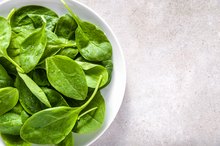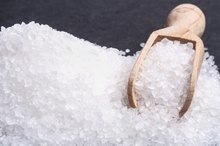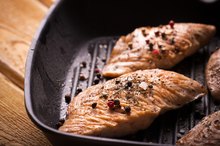Diet for Alcoholic Liver Disease
Alcohol is a toxin that in large quantities can affect your health. If your liver becomes cirrhotic, or scarred, your body’s ability to break down and absorb fats as well as fat-soluble vitamins is damaged. Because cirrhosis can affect your nutrition in so many ways, working with a dietitian can benefit you in planning meals that will keep your nutrient levels high.
Fats
When the liver cannot break down fat because it doesn't produce enough bile, fat passes unabsorbed in the stool. If you have mild fatty liver disease, which occurs in the early stage of alcoholic liver disease, reduce fat intake to 25 percent, the C. Everett Koop Institute states 1. Choose medium-chain triglycerides oil, a type of fat that doesn’t require bile for absorption and is more easily digested than other fats, for use in cooking. MCT oil is sold in health food stores.
- When the liver cannot break down fat because it doesn't produce enough bile, fat passes unabsorbed in the stool.
- If you have mild fatty liver disease, which occurs in the early stage of alcoholic liver disease, reduce fat intake to 25 percent, the C. Everett Koop Institute states 1.
Carbohydrates
Primary Biliary Cirrhosis Diet
Learn More
Complex carbohydrates such as whole grains, vegetables and fruits are the best sources of glucose, the body’s main fuel in alcoholic liver disease as well as the best source of vitamins and minerals often depleted in alcoholics. Alcohol especially depletes the B-complex vitamins found in whole grains including folate, or B-9 and B-1, called thiamine as well as B-6. Vitamin B-1 deficiency can cause brain damage called Wernicke-Korsakoff syndrome. People with alcoholic liver disease should not take a multivitamin or nutritional supplement without first getting a physician's approval, the National Liver Foundation warns 2.
- Complex carbohydrates such as whole grains, vegetables and fruits are the best sources of glucose, the body’s main fuel in alcoholic liver disease as well as the best source of vitamins and minerals often depleted in alcoholics.
- Alcohol especially depletes the B-complex vitamins found in whole grains including folate, or B-9 and B-1, called thiamine as well as B-6.
Protein
People with cirrhosis also need a diet rich in protein -- about 2,000 to 3,000 calories -- to repair damaged liver cells, according to the National Liver Foundation. However, protein may be restricted in some patients because too much protein can cause a buildup of ammonia in the blood. Do not add or restrict dietary protein without speaking to your doctor first.
Sodium
Foods Known to Damage the Liver
Learn More
Ascites, accumulation of fluid in the abdominal cavity, is a potentially life-threatening complication of alcoholic liver disease. People with ascites often need to restrict their sodium intake, because sodium increases fluid retention. Your doctor will determine the proper level of sodium restriction for you, but many limit sodium intake to 2,000 mg per day, according to the Digestive Health Center of Arizona 3. Canned soups, cold cuts and condiments as well as many processed meals contain very large amounts of sodium; avoid processed foods as much as possible and do not add salt to foods or when cooking.
- Ascites, accumulation of fluid in the abdominal cavity, is a potentially life-threatening complication of alcoholic liver disease.
- People with ascites often need to restrict their sodium intake, because sodium increases fluid retention.
Related Articles
References
- The C. Everett Koop Institute; Nutrition for Cirrhosis; 2011
- National Institutes of Health; Alcoholic Liver Disease; January 2005
- Digestive Health Center of Arizona; Ascites; 2011
- American Heart Association; Fat; 2011
- Bhatia SN, Underhill GH, Zaret KS, Fox IJ. Cell and tissue engineering for liver disease. Sci Transl Med. 2014;6(245):245sr2. doi:10.1126/scitranslmed.3005975
- Bémeur C, Butterworth RF. Nutrition in the Management of Cirrhosis and its Neurological Complications. Journal of Clinical and Experimental Hepatology. 2014;4(2):141-150. doi:10.1016/j.jceh.2013.05.008
- Yao C, Fung J, Chu N, Tan V. Dietary Interventions in Liver Cirrhosis. J Clin Gastroenterol. 2018;52(8):663-673. doi:10.1097/mcg.0000000000001071
- National Institute of Diabetes and Digestive and Kidney Diseases. Eating, Diet, & Nutrition for Cirrhosis. Published March 2018.
- Purnak T, Yilmaz Y. Liver disease and malnutrition. Best Practice & Research Clinical Gastroenterology. 2013;27(4):619-629. doi:10.1016/j.bpg.2013.06.018
- Barnard, Neal D., editor. Cirrhosis. Nutrition Guide for Clinicians, 3rd ed., Physicians Committee for Responsible Medicine, 2017.
- McClain CJ. Nutrition in Patients With Cirrhosis. Gastroenterology & hepatology. 2016;12(8):507-510.
- Angeli P, Bernardi M, Villanueva C, et al. EASL Clinical Practice Guidelines for the management of patients with decompensated cirrhosis. Journal of Hepatology. 2018;69(2):406-460. doi:10.1016/j.jhep.2018.03.024
- Ioannou GN, Morrow OB, Connole ML, Lee SP. Association between dietary nutrient composition and the incidence of cirrhosis or liver cancer in the united states population. Hepatology. 2009;50(1):175-184. doi:10.1002/hep.22941
- U.S. Department of Veterans Affairs. Eating tips for people with cirrhosis.
- Nakaya Y, Okita K, Suzuki K, et al. BCAA-enriched snack improves nutritional state of cirrhosis. Nutrition. 2007;23(2):113-120. doi:10.1016/j.nut.2006.10.008
- Suk KT, Baik SK, Yoon JH, et al. Revision and update on clinical practice guideline for liver cirrhosis. Korean J Hepatol. 2012;18(1):1-21. doi:10.3350/kjhep.2012.18.1.1
- Volk M. Liver cirrhosis: a toolkit for patients. University of Michigan Health System. Updated October 25, 2011.
- Runyon, B. Management of Adult Patients with Ascites Due to Cirrhosis. American Association for the Study of Liver Diseases (AASLD). Updated 2012.
- Runyon BA. Management of adult patients with ascites due to cirrhosis: Update 2012. American Association for the Study of Liver Diseases. 2012.
- Barkoukis H, Fiedler KM, Lerner E. A combined high-fiber, low-glycemic index diet normalizes glucose tolerance and reduces hyperglycemia and hyperinsulinemia in adults with hepatic cirrhosis. J Am Diet Assoc. 2002;102(10):1503-7. doi:10.1016/S0002-8223(02)90334-2
- National Institute of Health. LiverTox: Vitamin A. Updated July 1, 2019.
- Manguso F, D’Ambra G, Menchise A, Sollazzo R, D’Agostino L. Effects of an appropriate oral diet on the nutritional status of patients with HCV-related liver cirrhosis: A prospective study. Clinical Nutrition. 2005;24(5):751-759. doi:10.1016/j.clnu.2005.02.010. doi:10.1016/j.clnu.2005.02.010
Resources
Writer Bio
A registered nurse with more than 25 years of experience in oncology, labor/delivery, neonatal intensive care, infertility and ophthalmology, Sharon Perkins has also coauthored and edited numerous health books for the Wiley "Dummies" series. Perkins also has extensive experience working in home health with medically fragile pediatric patients.








